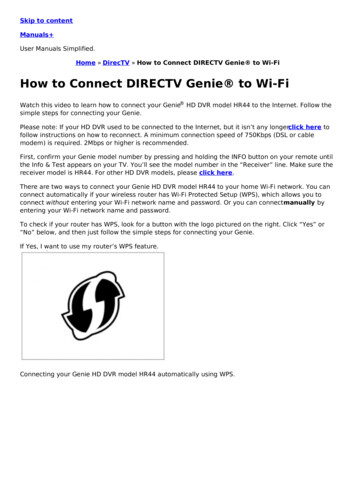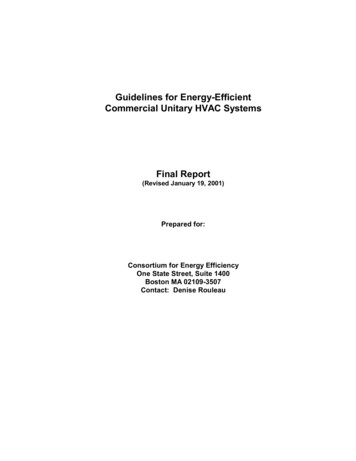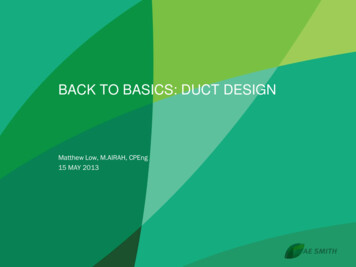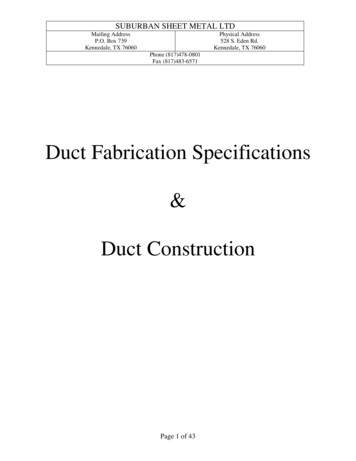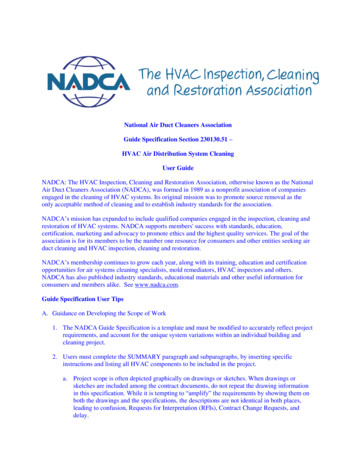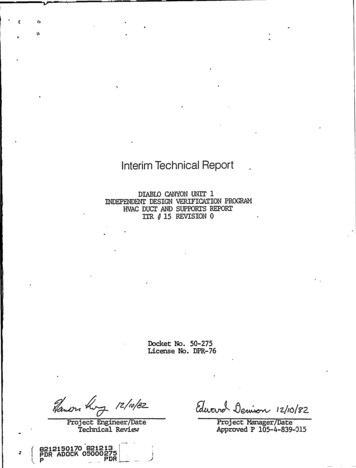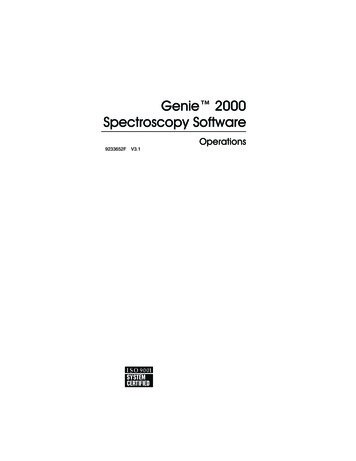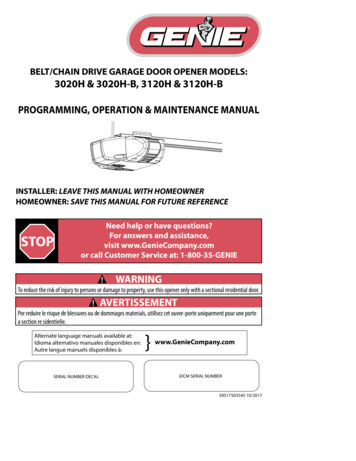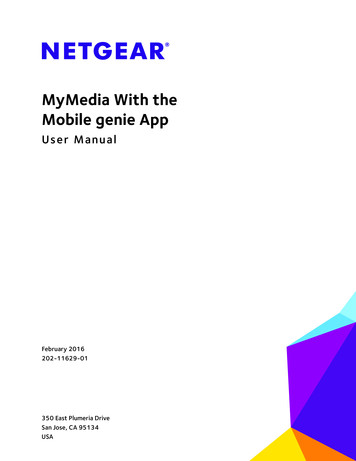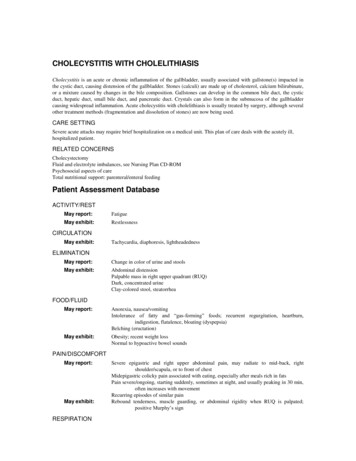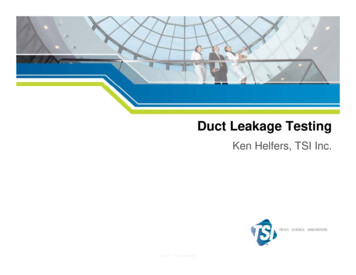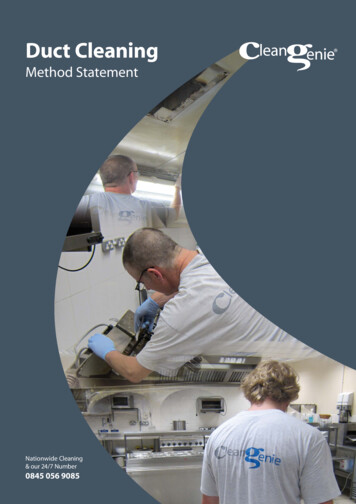
Transcription
Duct CleaningMethod StatementNationwide Cleaning& our 24/7 Number0845 056 9085
Ventilation Canopy & Grease Filter Cleaning. 3High Level Ventilation Canopy Cleaning. 4Ventilated Ceiling & Removable Ceiling Tile Cleaning . 5Installation of Access Doors in Ventilation Ducting . 6Cleaning of Ventilation Ducting Including Air HandlingUnits & Extract Fans (Excluding Plant Rooms & Roof Work). 7Cleaning & Replacement of Filters & Access Panels ofAir Handling Units. 8Cleaning of Extract Ducting & Extract Fans onRooftop Plant & Plant Rooms . alContentsHot Equipment Cleaning – Bain Maries, Stills Units, Jacketed Boilers,Combination Ovens & Other Water Based Equipment .11Hot Equipment Cleaning – Ovens/Stoves – Solid Tops,Burner Tops, Bratt Pans & Other Non-Water Based Equipment.11Hot Equipment Cleaning – Fat/Oil Fryers &Other Hot Oil Cooking Equipment .13Wall Cleaning – High & Low Level .14Floor Cleaning – Without Machinery ‘Altro’ & Non ‘Altro’ Floors. 15Floor Cleaning Using Electric Scrubber/Dryer –‘Altro’ & Non ‘Altro Floors.16Ceiling Cleaning – Stainless Steel – Painted –False & Clipped Tiles.17Cleaning High Level Ducting & Pipes.18Blind Cleaning – cument2
Duct Cleaning Method Statement3Ventilation Canopy & Grease Filter CleaningGeneral Note: Ideally once the filters have been cleaned they should be completely freeof grease and carbon deposits. In practice this may not be achievable resulting in onlythe surfaces being cleaned.1Operatives to check all PPE, cleaning equipment and chemicals required forthe task. Refer to COSHH assessments supplied for chemicals being used.Operatives to set out all ‘Caution/Warning’ signage required and cordon offcleaning area prior to work commencing.2Operatives to check hoses and connections for High Pressure Sprayer.Operatives to carry out electrical safety check of cabling and plug, ensurethat cable/ lead is sound and not severely kinked and that plug is notdamaged and machine has current PAT Test Certificate.3Operatives to check that 10kg cleaning tank is in fit condition, no holes ordamage to main body of tank.4Operatives to dispense cleaning chemicals into tank as per the COSHH datasheet instructions. Fill tank with water to recommended level and switchon heater.5Operatives to carefully remove filters one by one from canopy and place intotank, taking care not to over stack filters. Note: filters can be easily damagedespecially Vokes filters.6Operatives to let filters in tank soak for a minimum of 10 minutes.7After 10 minutes, operatives to remove filters one at a time from solution.Whilst also holding filters over the tank, clean the edges of the filters usinga ‘Greenie’.8Operatives to place filters into the spray tank and repeat process until spraytank is full.9Operatives to spray filters using high pressure jet sprayer in a methodicalway (as instructed by supervisor) ensuring that all parts of the facing side ofthe filter have been sprayed.10Operatives to repeat this procedure until completed on each side of filtersand then to repeat operation for reverse side of filters.11On completion, operatives to place filters carefully in drainage area and allowexcess water to drain out.Clean Genie Policy Document
While filters are draining operatives to dismantle the sprayer and all otherequipment ensuring that the cleaning and spray tanks are emptied andwaste solution is disposed of safely on site.13Once filters are dry, operatives to carry out a visual and manual qualityinspection to ensure that all grease and other debris have been successfullyremoved from filters.14Operatives are to replace the cleaned filters carefully back into the canopy.15On completion of cleaning, operatives to dispose of all waste chemicals andmaterials on site and remove all cleaning equipment, chemicals and signageto company vehicle.16Operatives are not to leave the site until authorised by Supervisor.This Method Statement to be used only to underpin a Full Site Specific Method StatementDuct Cleaning Method Statement12High Level Ventilation Canopy Cleaning1Operatives to check all PPE, cleaning equipment and chemicals required forthe task. Refer to COSHH assessments supplied for chemicals being used.Operatives to set out all ‘Caution/Warning’ signage required and cordon offcleaning area prior to work commencing.2Operatives are reminded that canopies can be fragile or may have loosescrews or bolts, seams can be broken and surface dented or misshaped.3Operatives to erect access equipment e.g. stepladder or ladder in the correctand safe manner. Ladders to be erected at the correct angle of 1:4 (75º). Ifworking between 2-6 metres height ladders must be footed or an approvedladder stopper or stabiliser used.4Operatives to take care if leaning ladder on to canopy cover, if possibleposition ladder on to nearest solid surface instead, e.g. wall.5Operatives to wear tool belt with all tools attached, this will leave bothhands free for climbing and descending ladder or step ladder. Operativesare reminded not to climb above 4 rungs from the tops of ladders or stepladders.6Operatives to clean canopy using the correct chemical on a clean clothor ‘Greenie’.Clean Genie Policy Document4
Duct Cleaning Method Statement57Operatives to rinse off surface of canopy with clean water and polish dryusing clean cloths, if necessary use stainless steel polish.8On completion of cleaning, operatives to dispose of all waste chemicals andmaterials on site. Remove all cleaning equipment, chemicals and signage tocompany vehicle.9Operatives are not to leave the site until authorised by Supervisor.This Method Statement to be used only to underpin a Full Site Specific Method StatementVentilated Ceiling & Removable Ceiling Tile Cleaning1Operatives to check all PPE, cleaning equipment and chemicals required for thetask. Refer to COSHH assessments supplied for chemicals being used. Operativesto set out all ‘Caution/Warning’ signage required prior to work commencing.2Operatives to check that any ceiling mounted, vent-axia type fans are turnedoff and controls isolated.3Operatives to secure the work area. Check client has arranged for gas andelectric of equipment below is turned off. Ensure client has arranged for allgas pilot lights to be extinguished. Ensure all controls are isolated includingair handling equipment.4Operatives to board over any open kitchen equipment e.g. hobs or ranges.Ensure equipment has cooled down sufficiently and cover all solid surfaceswith appropriate sheeting.5Operatives to set up access equipment e.g. trestle, step ladders, etc.6Operatives to ascend access equipment and carry out sealing procedure ofall holes and apertures.7Operatives to descend to floor level and prepare cleaning solution as per themanufacturer’s instructions. Note: refer to COSHH assessment supplied.8Operatives to check work equipment to be used as per cleaningspecification. Where steam cleaners are to be used check that all connectionsare properly tightened, electric cabling is sound and equipment has currentPAT test label or certificate.9Operatives to transfer cleaning equipment on to the access equipmenttaking care to ensure that no spillages occur and that safe manual handlingtechniques are observed.Clean Genie Policy Document
Operatives to commence cleaning of the ceiling. Cleaning to be carried outsystematically ensuring that each area of ceiling is cleaned and any excesssolution wiped off immediately from surrounding surfaces.11Operatives to pay extra care and attention where water or solution drips onto floors or may leak to basement areas below.12Operatives to rinse off cleaned section using clean water before progressingto next section.13On completing cleaning operations, operatives to descend from accessequipment and carefully remove cleaning equipment back to floor level,observing safe manual handling techniques.14Operatives to carry out a visual check of the ceiling from ground level toensure all areas have been cleaned as per the specification.15Operatives to dispose of all waste chemicals and materials on site andremove all cleaning equipment, chemicals and signage to company vehicle.16Operatives are not to leave the site until authorised by Supervisor.Duct Cleaning Method Statement10This Method Statement to be used only to underpin a Full Site Specific Method StatementInstallation of Access Doors in Ventilation Ducting1Operatives to check all PPE, cleaning equipment and chemicals required forthe task. Refer to COSHH assessments supplied for chemicals being used.Operatives to set out all ‘Caution/Warning’ signage required and cordon offcleaning area prior to work commencing.2Only trained operatives are allowed to carry out this task.3Operatives to ensure that if a ‘Permit to Work’ system is in place, that it is read,understood and signed by those undertaking the task.4Operatives to carry out survey of ducting to determine best area for accesspanel to be fitted.5Operatives to erect the necessary access equipment, step ladders or ladders(note where possible tops of ladders should be placed on to a solid surface).6Operatives to mark the cutting edge of access door using the templatesupplied.7Operatives to coat along the cutting edge with lubricant.Clean Genie Policy Document6
Duct Cleaning Method Statement8Operatives to drill a hole at each corner of the template marks.9Operatives to insert cutting equipment and cut a line from one corner holeto the next in rotation ensuring that cut is just short of the next hole. Oncompletion of cutting each line, operatives will finish cutting in to each hole.10Operatives to ease cut panel from ducting, taking care to avoid sharp edges.11Operatives to clean around edges of cut opening of ducting using generaldegreaser and clean cloth or ‘Greenie’ as necessary, taking care to avoid anysharp edges. If required, use file to remove sharp edges from cut panel edges.12Operatives to fit the frame of access door in to the ductwork using fold overcleats, then crimping to ensure a secure fit.13Operatives to then fit access door to framework.14Operatives to check access door opens and closes properly.15On completion of installation, operatives to dispose of cut panel and materialson site and remove all other chemicals and signage to company vehicle.16Operatives are not to leave the site until authorised by Supervisor.This Method Statement to be used only to underpin a Full Site Specific Method StatementCleaning of Ventilation Ducting Including Air HandlingUnits & Extract Fans (Excluding Plant Rooms & Roof Work)71Operatives to check all PPE, cleaning equipment and chemicals required forthe task. Refer to COSHH assessments supplied for chemicals being used.Operatives to set out all ‘Caution/Warning’ signage required and cordon offcleaning area prior to work commencing.2Operatives to erect access equipment e.g. stepladder or ladder in the correctand safe manner. Ladders to be erected at the correct angle of 1:4 (75º). Ifworking between 2-6 metres height ladders must be footed or an approvedladder stopper or stabiliser used.3Operatives are reminded that they will be working in a confined space andthat ducting has sharp edges, rivets or self-tapping screws sticking up whichare sharp, and that ducting can be fragile.4Operatives to check that all equipment sited below the supply systemis switched off and the controls are isolated.Clean Genie Policy Document
Operatives to check that all access doors are open and the room iswell ventilated.6Operatives to open all access panels in canopies and also where requiredremove ceiling panels to allow access to duct work in ceiling and remove allaccess panels where fitted. Operatives must not enter ducting until told itis safe to do so by Supervisor or Team Leader. Operatives must also notifySupervisor or Team Leader when entering any duct work.7Operatives to carry out an internal survey of ducting using a torch and makenote of where fans and ancillary motors or equipment are located insideducting.8Operatives to plug in RCD unit to power socket and vacuum cleaner andswitch power on.9Operatives to vacuum as much as possible dust and fluff from the ducting(ensure dust bag does not overfill and is emptied into a plastic bag at regularintervals). Where it is not possible to use a vacuum cleaner operatives willbrush & scrape by hand grease, dust & carbon deposits. Extra care should betaken as this will raise dust in to the air.10Operatives to clean both sides of impeller blades using a hand brush.11Operatives to empty all debris in to plastic bags.12On completion of cleaning, operatives to dispose of all debris and materialson site and remove all cleaning equipment, and signage to company vehicle.13Operatives are not to leave the site until authorised by Supervisor.Duct Cleaning Method Statement5This Method Statement to be used only to underpin a Full Site Specific Method StatementCleaning & Replacement of Filters & Access Panels ofAir Handling Units1Operatives to check all PPE, cleaning equipment and chemicals required forthe task. Refer to COSHH assessments supplied for chemicals being used.Operatives to set out all ‘Caution/Warning’ signage required and cordon offcleaning area prior to work commencing.2Operatives to erect access equipment e.g. stepladder or ladder in the correctand safe manner. Ladders to be erected at the correct angle of 1:4 (75º). Ifworking between 2-6 metres height ladders must be footed or an approvedladder stopper or stabiliser used.Clean Genie Policy Document8
Duct Cleaning Method Statement3Operatives to ensure that air handling units are switched off and the controlsisolated.4Operatives to open filter housing unit and remove filters from unit one at a time.5If applicable, Operatives to clean filter housing unit using cleaning chemical,applied either on a clean cloth or ‘Greenie’.6If applicable, Operatives to rinse area with clean warm water using a cleancloth and buff dry.7If applicable, Operatives to insert new filters in to the unit one at a time andensure a correct and secure fit.8Operatives to close filter housing unit.9Operatives to remove access equipment from area.10Operatives to switch power back on at isolation point.11On completion of cleaning, operatives to dispose of all waste materials onsite and remove all equipment and signage to company vehicle.12Operatives are not to leave the site until authorised by Supervisor.This Method Statement to be used only to underpin a Full Site Specific Method StatementCleaning of Extract Ducting & Extract Fans onRooftop Plant & Plant RoomsGeneral Note: Operatives should be reminded of the Risks & Hazards associated withworking at height and in plant rooms, e.g. no work should be under taken on rooftopequipment unless adequate edge or fall protection devices have been installed. Plantrooms have narrow or confined spaces and that head height can be very limited, withducting and other plant & equipment protruding. Ducting can be fragile, have sharpedges or screws or bolts that can protrude.Plant Room Cleaning91Operatives to check all PPE, cleaning equipment and chemicals required for thetask. Refer to COSHH assessments supplied for chemicals being used. Operativesto set out all ‘Caution/Warning’ signage required prior to work commencing.2The Team Leader has to ensure that a ‘Permit to Work’ is issued, that it isread, understood and signed by those undertaking the task. A drawing orblueprint of the roof top ducting & plantroom must be attached to the‘Permit’. Also, if required, ensure that all keys to roof access doors and plantroom are signed for.Clean Genie Policy Document
The Team Leader is to check that all equipment sited below roof level and inthe plant room is switched off and the controls are isolated.4Operatives to proceed to the roof area via the designated safe route, openroof access door & proceed to the roof top plant room.5Operatives are to check the blueprint/drawing matches the plant room& ducting.6Operatives to then commence cleaning operations inside the plant room.Roof Operations7Team Leader to climb up on to the roof systems using a ladder or step ladderto gain access and carry out survey to determine if access panels need to becut and inserted. Note: Team Leader to determine the safe climbing routealso if roof top is fitted with edge or fall protection devices.8Once the Team Leader has determined that the area is safe to work on they willinstruct the operatives of where cleaning where access panels are to be inserted.9The operatives will then climb onto the structure and if required will attachtheir inertia safety line to the nearest safety eyebolt or latchway system.10The operatives will cut out panels as required and insert the new accesspanels while cleaning areas as necessary.11On completion of all operations the operatives will pack all waste materialsinto strong plastic bags for disposal on site.12The operatives will then descend from plant room roof ensuring that allequipment and waste is accounted for. The operatives working inside theplant room will also ensure that their equipment and waste is accounted for.13The Team Leader will then shut and lock the plant room access door, beforeleading all operatives back to the roof access door. Once through the roofaccess door the Team Leader will then shut and lock the door and descenddown to ground level via the safe designated route.14The Team Leader will then sign off the ‘Permit to Work’ and sign back in anykeys to roof access doors.15The operatives will then dispose of all waste materials on site and remove allchemicals, signage and equipment to company vehicles.16Operatives are not to leave the site until authorised by Supervisor.Duct Cleaning Method Statement3This Method Statement to be used only to underpin a Full Site Specific Method StatementClean Genie Policy Document10
Duct Cleaning Method StatementHot Equipment Cleaning – Bain Maries, Stills Units,Jacketed Boilers, Combination Ovens & Other WaterBased EquipmentGeneral Note: All equipment must be switched off and controls isolated wherepossible, pilot lights extinguished and gas valves or taps closed.1Operatives to check all PPE, cleaning equipment and chemicals required forthe task. Refer to COSHH assessments supplied for chemicals being used.Operatives to set out all ‘Caution/Warning’ signage required and cordon offcleaning area prior to work commencing.2Operatives are to ensure that the equipment is emptied of all contents and iscool to touch before starting any cleaning.3Operatives are to clean the equipment as per training and specification.4Operatives are to clean up any spillages immediately to ensure that othersurfaces are not marked or damaged by the chemicals or solutions being used.5Operatives will ensure that the equipment is reassembled in the correctmanner and check that all controls are working correctly.6On completion of cleaning, operatives to dispose of all waste chemicals andmaterials on site and remove all cleaning equipment, chemicals and signageto company vehicle.7Operatives are not to leave the site until authorised by Supervisor.This Method Statement to be used only to underpin a Full Site Specific Method StatementHot Equipment Cleaning – Ovens/Stoves – Solid Tops,Burner Tops, Bratt Pans & Other Non-Water BasedEquipment111Operatives to check all PPE, cleaning equipment and chemicals required forthe task. Refer to COSHH assessments supplied for chemicals being used.Operatives to set out all ‘Caution/Warning’ signage required and cordon offcleaning area prior to work commencing.2Operatives to carry out safety check of Hot equipment prior to starting worke.g. ensure the client has arranged for the equipment to be turned off, pilotlights extinguished, gas / electric controls are isolated and the equipment iscool to touch.Clean Genie Policy Document
Operatives to fill dip tank with clean hot water.4Operatives to dismantle the equipment by hand, taking care to note eachpart for re-assembly on completion of cleaning.5Operatives to place all non aluminium parts in to dip tank.6Operatives to mix a solution of the recommended cleaning solution,following manufacturers instructions and the COSHH assessment supplied,and carefully pour into the dip tank.7Operatives to allow equipment to soak for at least 2 hours, to ensure that allgrease and grime is lifted from surface.8While equipment is soaking, clean the remainder of equipment usingchemical cleaning agent and paint scrapers as necessary, paying carefulattention to detail by cleaning to edges and corners.9Where possible operatives to remove switches and knobs to aid cleaning,ensuring they are replaced in exactly the same position.10After equipment has soaked in dip tank, operatives to clean equipmentusing a ‘Greenie’ or sponge as necessary and rinse with clean water.11On completion, operatives to reassemble the equipment ensuring all partsare fitted in to original positions and coat solid tops with a thin layer ofcooking oil.12Operatives to re-light any pilot lights and test that the equipment is workingcorrectly.13On completion of cleaning, operatives to dispose of all waste chemicals andmaterials on site and remove all cleaning equipment, chemicals and signageto company vehicle.14Operatives are not to leave the site until authorised by Supervisor.Duct Cleaning Method Statement3This Method Statement to be used only to underpin a Full Site Specific Method StatementClean Genie Policy Document12
Duct Cleaning Method Statement13Hot Equipment Cleaning – Fat/Oil Fryers &Other Hot Oil Cooking Equipment1Operatives to check all PPE, cleaning equipment and chemicals required forthe task. Refer to COSHH assessments supplied for chemicals being used.Operatives to set out all ‘Caution/Warning’ signage required and cordon offcleaning area prior to work commencing.2Operatives to ascertain type of equipment to be cleaned eg. small tablemounted or large free standing type. Check if gas or electrically operated todetermine if the equipment can be moved. Note: If equipment is connectedvia a flexible gas lead, check where gas shut off valve is located and seekpermission before disconnecting from mains supply, this will also apply toelectrically operated equipment.3Operatives to check that the equipment has been emptied of all fat or oil, ifnot then operatives will have to drain the equipment into clean receptaclessupplied by the client. Operatives should take care when draining theequipment not to contaminate the fat or oil. If contamination should occuroperatives are to inform their supervisor immediately. Note: operativesto carry out visual inspection and note condition of the fat or oil prior todraining the equipment.4Operatives to remove oil to a safe area, away from cleaning operations, andensure that containers are covered and/ or lids closed and secure.5Operatives to check which chemicals have been specified for the job.Operatives to decant carefully from large container in to smaller spray bottles.6Operatives to thoroughly spray all surfaces of the equipment with cleaningchemical, eg. Heavy Duty Degreaser and allow to soak for at least five minutes.7Operatives to clean surfaces of the equipment using the recommendedcleaning chemical with a cloth. It may be necessary to use a ‘Greenie’ or paintscraper especially on the external surfaces. Operatives should take care not todamage any surfaces and report any defects immediately to their supervisor.8Operatives to ensure that all internal surfaces are thoroughly cleaned,especially the areas around drainage taps.9Once all grease and carbon deposits have been removed, operatives to thengive a final thorough rinse to all surfaces using clean warm water and finallypolish dry using paper towels.Clean Genie Policy Document
Operatives to replenish the equipment with clean oil if supplied. Ifequipment is gas operated, operatives to ensure the pilot light is lit.Alternatively if electrically operated, operatives to insert the plug in to thepower socket.11On completion of cleaning, operatives to dispose of all waste chemicals andmaterials on site and remove all cleaning equipment, chemicals and signageto company vehicle.12Operatives are not to leave the site until authorised by Supervisor.This Method Statement to be used only to underpin a Full Site Specific Method StatementWall Cleaning – High & Low Level1Operatives to check all PPE, cleaning equipment and chemicals required forthe task. Refer to COSHH assessments supplied for chemicals being used.Operatives to set out all ‘Caution/Warning’ signage required and cordon offcleaning area prior to work commencing.2Operatives to carry out survey of area to check that the correct accessequipment has been supplied for the task. Be aware that walls may carryun-lagged pipes which may contain steam or hot water and may causeburns to bare skin on contact.3Operatives to check that all portable electrical appliances are switched offand if possible removed from area. Ensure power sockets of fixed electricalappliances are turned off and where possible power sockets are isolated.4Operatives are not to stand on any kitchen work surfaces, drainers, stovesor ovens. Operatives to place suitable boards over the equipment, e.g.youngmans boards.5Operatives to sign off areas of work and commence cleaning by sprayingchemical solution, allowing this to soak for approximately one minute. Note:extra care to be should taken when spraying near to electrical power sockets(if possible cover and seal the sockets prior to spraying) do not over spray.6Operatives to wash surfaces using a clean cloth or ‘Greenie’, if surface permits.On painted plain surfaces do not over apply pressure or use a strongersolution since this will leave run marks. On tiled or PVC surfaces finish cleaningby polishing off to a clean smear free shine using clean dry paper towelling.Clean Genie Policy DocumentDuct Cleaning Method Statement1014
Duct Cleaning Method Statement7On completion of cleaning, operatives to dispose of all waste chemicals andmaterials on site and remove all cleaning equipment, chemicals and signageto company vehicle.8Operatives are not to leave the site until authorised by Supervisor.This Method Statement to be used only to underpin a Full Site Specific Method StatementFloor Cleaning – Without Machinery ‘Altro’ & Non ‘Altro’ FloorsApplicable to both ‘Altro’ and non ‘Altro’ floors1Operatives to check all PPE, cleaning equipment and chemicals required forthe task. Refer to COSHH assessments supplied for chemicals being used.Operatives to set out all ‘Caution/Warning’ signage required and cordon offcleaning area prior to work commencing.Cleaning non ‘Altro’ floors152Operatives to mix cleaning solution in bucket.3Operatives to mop the floor with the solution ensuring floor is wet (not justdamp) and allow solution to work for approximately 3-4 minutes beforechecking the area and scrapping off any large deposits of grease or grime.4On quarry tiled floors, operatives to check the grouting to ensure all greaseand grime has been removed. If required use a sponge or ‘Greenie’ to cleanthe grouting afterwards. Note: operatives are advised to make note of anydamaged grouting and report this to the Supervisor.5Operatives to check the wall/ floor junctions to ensure that they are clean. Ifnecessary, use sponge or ‘Greenie’ to clean.6Operatives to use manual floor scrubber and thoroughly scrub the floor.7Operatives to remove excess solution from the floor using a wetvac machine.8Operatives to rinse floor by mopping with clean hot water. Note: this processmay need to be repeated several times to achieve required standard of finish,whereby surface is free from grease and dirt and has a smooth, clean, smearfree look to it.9On completion of cleaning, operatives to dispose of all waste chemicals andmaterials on site and remove all cleaning equipment, chemicals and signageto company vehicle.Clean Genie Policy Document
Operatives are not to leave the site until authorised by Supervisor.Cleaning ‘Altro’ floors11Operatives are to use ‘Altro’ floor cleaning solution.12Operatives then to follow points 3 to 10 above, omitting point 4.This Method Statement to be used only to underpin a Full Site Specific Method StatementFloor Cleaning Using Electric Scrubber/Dryer –‘Altro’ & Non ‘Altro Floors1Operatives to check all PPE, cleaning equipment and chemicals required forthe task. Refer to COSHH assessments supplied for chemicals being used.Operatives to set out all ‘Caution/Warning’ signage required and cordon offcleaning area prior to work commencing.2Carry out pre-work safety check of the machine i.e. cut/ broken lead,damaged plug, damaged or broken discs or brushes.3Check that machine has got current PAT test certificate/ label.4Operatives to assemble machine as per manufacturer’s safe operatinginstructions.5Operatives to ventilate area if required (this can be done by openingwindows, doors or turning on ventilation equipment if necessary).6Operativ
Duct Cleaning Method Statement 7 Operatives to rinse off surface of canopy with clean water and polish dry using clean cloths, if necessary use stainless steel polish. 8 On completion of cleaning, operatives to dispose of all waste chemicals and materials on site. Remove all cleaning equipment, chemicals and signage to company vehicle.
